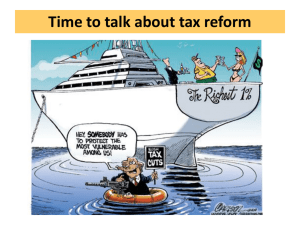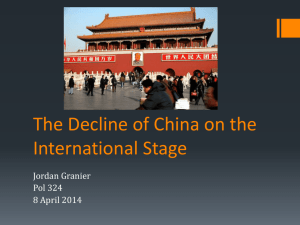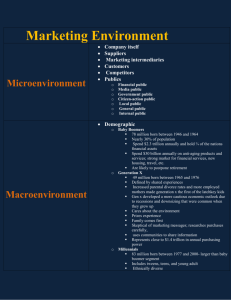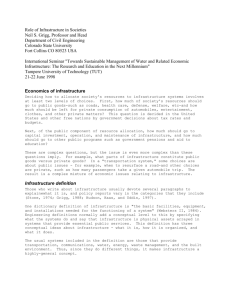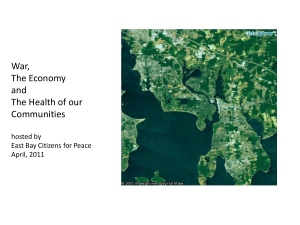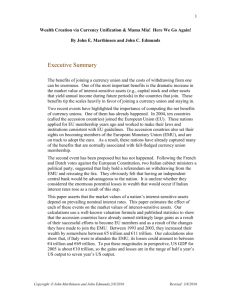Boston College Social Welfare Research Institute
advertisement
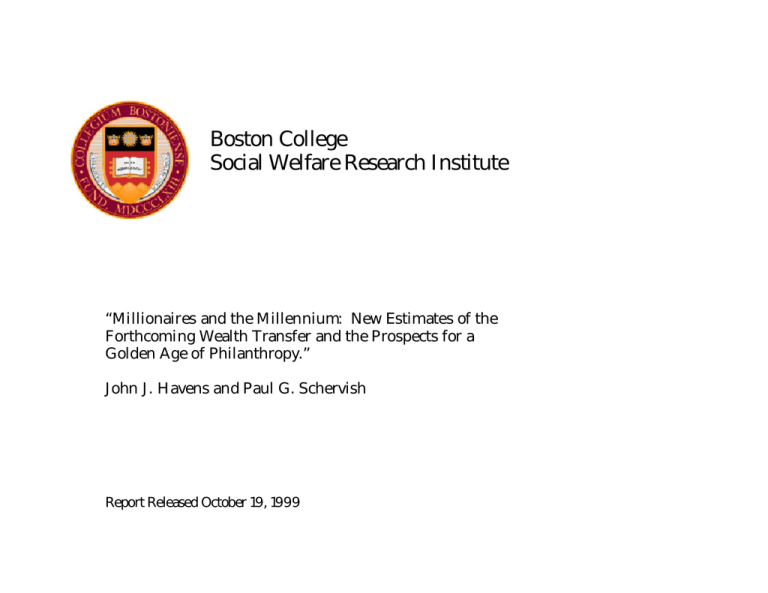
Boston College Social Welfare Research Institute “Millionaires and the Millennium: New Estimates of the Forthcoming Wealth Transfer and the Prospects for a Golden Age of Philanthropy.” John J. Havens and Paul G. Schervish Report Released October 19, 1999 Millionaires and the Millennium: New Estimates of the Forthcoming Wealth Transfer and the Prospects for a Golden Age of Philanthropy John J. Havens and Paul G. Schervishi Contact: Social Welfare Research Institute Boston College (617) 552-4070 swri508@bc.edu October 19, 1999 Introduction The following overview presents the first new wealth transfer estimates to be generated since 1990, the assumptions used to generate these estimates, and a glimpse at the implications of this wealth transfer for charitable giving. In a forthcoming full report with the same title, we will present a more detailed portrait of the pending wealth transfer, the methodology we used to obtain this estimate, and the implications for the level of charitable giving, especially by wealth holders, over the first half of the next century. We will also suggest strategies by which fundraisers and financial advisors can guide wealth holders to shift even greater portions of their net worth to charity, in the form of both inter-vivos gifts and bequests. These new forecasts were developed by the authors at the Boston College Social Welfare Research Institute with support from the T. B. Murphy Foundation Charitable Trust (Michigan) and the Lilly Endowment, Inc. On the basis of a recently developed Wealth Transfer Microsimulation Model (WTMM), we estimate that the forthcoming transfer of wealth will be many times higher than the almost universally cited 55-year figure of $10 trillion. Our low-range best estimate is that over the 55-year period from 1998 to 2052 the wealth transfer will be $41 trillion, and may well reach double or triple that amount. Depending upon the assumptions we introduce into the model (for instance, in regard to the current level of wealth, real growth in wealth, and savings rates) we estimate the wealth transfer will range from a lower level figure of $41 trillion to an upper level figure of $136 trillion. These estimates are not back-of-the-envelope projections. They emerge from what to our knowledge is a first-of-its-kind microsimulation model of wealth accumulation and transfer. The new estimates update the figure published in 1990 by Robert Avery and Michael Rendall1--and regularly cited ever since then-indicating that over the 55-year period from 1990 to 2044, the value of estates in the United States passing from adults with children 50 years and older would be $10.4 trillion. Until our estimates circulate and others have a chance to review and criticize our work, we suggest that the focus be placed on the low-end estimate of $41 trillion. It is not because we believe our middle level estimate of $73 trillion to be unreasonably high, or our upper level estimate of $136 to be implausible. For instance, the $73 trillion estimate assumes a maximum real growth rate of 3% for the next 55 years, and assumes that the value of assets held by individuals in 1998 was $32 trillion, which is 18% lower than the $39 trillion figure recently cited in Worth magazine (September, 1999, p. 97) and lower than a recent Federal Reserve estimate of private wealth of $37.4 trillion. However, because no simulation estimates are any better than the assumptions on which they are based, and because we anticipate refining our estimates in the light of suggestions and criticism by others, we suggest that for the time being most credence be given to the $41 trillion estimate. Emphasizing the $41 trillion lower-level estimate with its 2% secular growth rate helps protect against potential charges of “irrational exuberance” arising from our not yet having modelled periodic recessions, a world economic crisis, or depression. 1 Robert B Avery and Michael S Rendall. "Estimating the Size and Distribution of the Baby Boomers' Prospective Inheritances." Department of Consumer Economics and Housing, Cornell University, Ithaca, NY 14853. “The $10 Trillion Transfer” Avery and Rendall’s original figure has become known in academic, professional, and media circles as the “forthcoming $10 trillion intergenerational transfer of wealth” or, more simply, as “the $10 trillion transfer.” Although Avery and Rendall did not calculate this figure primarily for the purpose of estimating the amount of wealth transfer, over the past decade their estimate has become the most frequently cited statistic in discussions about charitable giving. Avery and Rendall were originally interested in saving behavior and sought to learn whether the size of an expected inheritance led to a tendency by heirs to save less. As such, Avery and Rendall calculated the intergenerational wealth only for families whose head was age 50 or older and had living children. From time to time, commentators have adjusted the $10.4 trillion figure to reflect changes in the cost of living, producing wealth transfer estimates in the range of $12-$13 trillion. Sometimes, when writers or reporters informally calculate the amount of the pending wealth transfer that will come from the very wealthy, they come up with a transfer estimate somewhere around $7 trillion. We want to be clear that we are not criticizing any aspect of Avery and Rendall’s estimate or research, other than the fact that they have been misunderstood and that their estimate has ended up being used for purposes for which it was not designed. Many who make reference to the $10 trillion inter-generational transfer not only fail to realize that the original estimate was a by-product of other research on prospective savings rates by heirs, and limited to a specific demographic group. They also regularly overlook the fact that the $10 trillion wealth transfer is an amount projected to occur over 55 years, and not over a ten- to twenty-year period. Equally important, most of those citing the $10 trillion figure mistakenly assume that the $10 trillion is fully discretionary, thereby encouraging the erroneous expectation that that the full $10 trillion is to be divided only between heirs and philanthropy. Overlooked is the fact that a large part of the transfer will go to estate taxes and, to a much lesser extent, fees. It is important to be aware of these misconceptions when, for instance, we indicate that our lower level 55-year estimate of $41 trillion will entail a $6 trillion transfer to charity. The figure of $6 trillion, which is approximately 15% of the total $41 trillion, should not be contrasted to the current figure of $10 trillion but to a figure of about $1.5 trillion that would be bound for bequests if in fact the forthcoming transfer were $10 trillion instead of $41 trillion. Similarly, when we speak of a twenty-year lower level wealth estimate of a $12 trillion total wealth transfer and a $1.7 trillion transfer via charitable bequests, these figures should be compared to what the 55-year $10 trillion dollar transfer would look like over 20 years, namely, a $2.8 trillion transfer of wealth and about $0.4 trillion in charitable bequests. The $41 Trillion Transfer of Wealth Our microsimulation projections are detailed in Tables 1 - 3. All dollar figures in these tables represent millions of 1998 dollars. The tables follow the same format. The first panel in each table presents the results of the simulation for the 20-year period from 1998 through 2017. The second panel in each table presents the results of the simulation for the 55-year period from 1998 through 2052. The columns in each table categorize estates by the value of the final estate in 1998 dollars at the time of death of the final decedent. The rows of each panel present the estimated number of final estates, the aggregate value of these estates, the aggregate burial and estate fees for these estates, the aggregate federal and state estate taxes levied against these estates, the aggregate estimate of bequests to charities from these estates, and the aggregate bequests to heirs (other than spouse) from these estates. As we detail in a subsequent section of this overview, the low, middle, and high level scenarios differ mostly in the combined rates of change used to simulate modifications in household wealth. The lower level scenario assumes a sustained 2% rate of real growth in wealth in combination with low lifecycle savings and high lifecycle dissavings rates. The middle level scenario sets up a baseline case of a sustained 3% rate of real growth in wealth in combination with lifecycle variations in the rates of change in wealth. The upper level simulation model assumes a sustained 4% rate of real growth in wealth in combination with high lifecycle savings and low lifecycle dissavings rates. All three scenarios reproduce the underlying distributional dynamics currently occurring in estates. The larger the estate, the greater the proportion that goes to charity and the smaller the proportion that goes to heirs. For final estates valued at $20 million or more, approximately 39% in each scenario will go to charity, 23% to heirs, 34% to taxes, and 3% for fees and burial costs. For final estates valued at $1 to $4.9 million the current and simulated figures are approximately 8% to charity, 66% to heirs, 22% to taxes, and 4% for fees and burial costs. In all scenarios, the simulated growth rates operate both directly on the value of wealth accumulated and indirectly through influencing the value of simulated inheritances received during the period.) [Detail: In both the 20-year and the 55-year period, most of the value (90% for the 20-year period and 87% for the 55-year period) of final estates valued at less than $1 million passes to heirs (other than spouse). As the value of final estates increases above the $1 million dollar level the proportion of the value passing to heirs declines until it reaches 23% for estates valued at $20 million or more in both periods. Estate taxes follow the reverse pattern: there are low levels of estate taxes levied on estates of less than $1 million (1% in the 20-year and 4% in the 55-year period). The proportion increases with the value of the estate until it reaches a peak value for the $10 to $20 million of 43% for both periods. For even larger values of estates of $20 million or more the proportion of the value of the estate going to taxes actually declines to 34% for both periods. The decline occurs because the highest valued estates, subject to the highest rates of estate taxes, give larger proportions to charitable organizations which has the effect of lowering the estate taxes they pay. The proportion of the value of estates bequeathed to charity increases with the value of the estate from 5% (for both periods) for estates of less than $1 million to 39% (for both periods) for estates of $20 million or more.] Table 1 Wealth Transfer Lower Level Estimates Number of Estates Value of Estates Estate Fees Estate Taxes Neg or Zero $1 to $.9M 1,262,3904.89% 22,722,96287.98% 1,555,521 6.02% ($13,143)- $3,936,73333.83% - 100.00% $358 0.08% 0.00% $0 - Bequest to Charity 0.00% $0 Value of Estates Estate Fees 0.00% $0 68,7740.27% 57,8070.22% 25,827,575100.00% $3,180,36627.33% $1,110,7099.54% $941,2178.09% $2,468,30321.21% $11,624,185100.00% 100.00% 100.00% 100.00% 100.00% 100.00% $148,01432.49% $128,91328.29% $49,124 10.78% $43,1339.47% $86,08618.89% $455,628 100.00% 3.76% 4.05% 4.42% 4.58% 3.49& 3.92% $38,837 1.62% $199,798 28.50% $683,920 21.50% 11.61% 14.92% $256,819 8.08% $3,550,084 50.27% $2,110,714 29.89% 66.37% 5,325,0556.06% ($50,856) - $13,933,31734.27% - 100.00% $784 0.00% $0 0.00% $0 0.00% $0 - 32.90% $523,820 3.76% $270,524 1.94% $717,542 5.15% $12,421,430 89.15% $151,229 34.11% 8.79% 16.07% $477,093 6.76% $341,736 20.64% 55.68% $958,242 38.82% 4.84% 36.31% $582,073 $2,399,500100.00% $1,720,857100.00% 14.80% 8.24% 23.58& $7,061,700100.00% 60.75% Total 495,0670.56% 240,7500.27% 203,3360.23% 87,839,311100.00% $11,361,85927.95% $3,338,664 8.21% $3,334,2768.20% $8,687,63521.37% $40,604,894 100.00% 100.00% 100.00% 100.00% 100.00% 100.00% $464,098 29.15% $147,692 9.28% 4.42% 29.73% $2,521,800 15.36% $924,960 $1,289,458 15.20% $7,451,001 65.58% 7.70% $463,626 Figures in upper-right hand corner of cells are percentages by category and add across Figures below are percentages of the value of estates and add down All dollar values are in millions of $1998 $1,437,888 43.07% $153,640 $1,445,628 $526,158 17.04% 8.74% $1,208,851 36.26% $2,956,108 $3,389,897 $6,022,182100.00% 14.83% 8.30% $2,039,483 23.48% $8,483,517100.00% 20.89% 56.29% 39.02% 4.92% $1,592,182100.00% 3.92% 34.85% 34.03% 15.78$ 5.85% $302,147 18.98% 3.48% 43.36% 13.89% 30.34% 9.65% 4.61% 38.62% 8.14% 50.58% $154,769 8.99% $841,901 $20M or more 22.20% 11.91% 43.04% 35.09% $10M to $19.9M 4.08% 3.19% $405,119 38.69% Panel 2 1998-2052 $1M to $4.9M $5M to $9.9M 76,593,32287.20% 16.88% $429,723 42.95% 4,981,7825.67% 0.05% 17.91% 13.93% $1 to $.9M - Bequest to Heirs 160,121 0.62% Neg or Zero - Bequest to Charity Total 90.18% - Estate Taxes $20M or more 5.08% - Number of Estates $10M to $19.9M 0.99% - Bequest to Heirs Panel 1 1998-2017 $1M to $4.9M $5M to $9.9M $24,558,653100.00% 60.48% Table 2 Wealth Transfer Middle Level Estimates Number of Estates Value of Estates Estate Fees Panel 1 1998-2017 $1M to $4.9M $5M to $9.9M Neg or Zero $1 to $.9M $10M to $19.9M $20M or more Total 1,209,9274.68% 22,432,47686.85% 1,816,921 7.03% 215,3630.83% 82,2480.32% 70,6410.27% 25,827,575100.00% ($9,277)$354 0.06% $4,679,77633.00% 100.00% $3,791,34426.74% $1,479,134 10.43 $1,099,3097.75% $3,131,068 22.08% $14,171,354 100.00% 100.00% 100.00% 100.00% 100.00% $175,951 31.71% 100.00% $154,08427.77% $65,41911.79% $50,4039.08% $108,69319.59% $554,905100.00% - Estate Taxes 0.00% $0 3.76% 4.06% 4.42% 4.58% 3.47% 3.92% $61,2792.04% $827,01227.58% $573,68719.13% $472,804 15.77% $1,063,698 35.47% $2,998,480100.00% - Bequest to Charity 0.00% $0 1.31% 21.81% 38.79% 43.01% 33.97% 21.16% $237,20911.02% $308,204 14.31% $206,9609.61% $174,8708.12% $1,225,83956.93% $2,153,081100.00% - Bequest to Heirs 0.00% $0 - Number of Estates Value of Estates Estate Fees 5.07% 8.13% 13.99% 15.91% 39.15% 15.19% $4,205,338 46.62% $2,502,04329.52% $633,0697.47% $401,2324.73% $732,8378.65% $8,474,519100.00% 89.86% 65.99% 42.80% 36.50% 23.41% 59.80% $10M to $19.9M $20M or more Total Panel 2 1998-2052 $1M to $4.9M $5M to $9.9M Neg or Zero $1 to $.9M 4,285,3144.88% 70,088,37679.79% 11,371,88912.95% 1,265,0721.44% 487,5470.56% 341,1120.39% 87,839,311100.00% ($29,331)- $17,368,68923.81% $24,134,61133.09% $8,579,82011.76% $6,469,1608.87% $16,382,51522.46100.00% $72,905,464 100.00 - 100.00% 100.00% 100.00% 100.00% 0.02% $562 22.52% $652,983 $999,668 34.48% $379,661 13.09% $298,331 10.29% 100.00% $568,447 19.60% $2,899,652100.00% __- 3.76% 4.14% 4.43% 4.61% 3.47% 3.98% Estate Taxes $00.0% $672,308 3.73% $5,664,77231.39% $3,343,41418.52% $2,804,654 15.54% $5,563,33530.82% $18,048,483100% - 3.87% 23.47% 38.97% 43.35% 33.96% 24.76% Bequest to Charity $00.0% $937,6188.10% $1,992,37317.22% $1,208,44110.45% $1,011,3068.74 % $6,419,19755.49% $11,568,936100% - 5.40% 8.26% 14.08% 15.63% 39.18% 15.87% Bequest to Heirs $00.0% $15,105,78037.37% $15,477,798 38.29% $3,648,3059.03% $2,354,868 5.83% $3,831,5369.48% $40,418,287100% - 86.97% 64.13% 42.52% 36.40% 23.39% 55.44% Figures in upper-right hand corner of cells are percentages by category and add across Figures below are percentages of the value of estates and add down All dollar values are in millions of $1998 Table 3 Wealth Transfer Higher Level Estimates Panel 1 1998-2017 $1M to $4.9M $5M to $9.9M Neg or Zero $1 to $.9M 1,123,891 4.35% 21,827,24984.51% 2,399,101 9.29% Value of Estates ($6,165)- $5,333,61530.40% $4,848,94327.64% - 100% 100% 100% 100% 100% 100% Estate Fees $254 0.04% $200,52929.07% $197,83228.68% $84,71712.28% $71,521 10.37% $135,05919.58% $689,911100% - 3.76% 4.08% 4.43% 4.60% 3.47% 3.93% Estate Taxes $00.0% $98,3572.52% $1,062,48327.26% $742,80319.06% $672,12517.24% $1,321,78633.91% $3,897,553100% - 1.84% 21.91% 38.80% 43.26% 33.96% 22.23% Bequest to Charity $00.0% $271,01410.04% $391,668 14.51% $267,6239.91% $244,7899.07% $1,524,74956.48% $2,699,842100% - 5.08% 8.08% 13.98% 15.75% 39.18% 15.40% Bequest to Heirs $00.0% $4,763,71546.45% $3,196,961 31.17% $819,0607.99% $565,3835.51% $910,3958.88% $10,255,513100% - 89.31% 65.93% 42.79% 36.39% 23.39% 58.48% Number of Estates Number of Estates Value of Estates Estate Fees Estate Taxes $1 to $.9M 3,746,158 4.26% 58,915,72567.07% 20,448,961 23.28% ($19,348)- $17,558,32312.89% - 100% $428 0.01% - $0 - Bequest to Charity 0.00% $0 - Bequest to Heirs 0.00% $0 - $20M or more Total 280,1671.08% 115,3270.45 81,8390.32% 25,827,575100% $1,914,20210.91% 115,3270.45% $3,891,98822.19% $17,536,399100% Panel 2 1998-2052 $1M to $4.9M $5M to $9.9M Neg or Zero 0.00% $10M to $19.9M $10M to $19.9M $20M or more Total 2,794,0773.18% 1,191,398 1.36% 742,991 0.85% 87,839,311100% $46,863,75934.41% $19,142,27214.06% $16,237,734 11.92% $36,374,15726.71% $136,156,897100% 100.00% 100.00% 100.00% 100.00% 100.00% $664,08712.02% $2,000,27536.22% $848,14415.36% $747,37313.53% $1,262,81822.86% $5,523,125100% 3.78% 4.27% 4.43% 4.60% 3.47% 4.06% $1,018,428 2.51% 5.80% $994,180 5.66% 84.76% $12,687,522 27.07% 4.01% 14,881,628 31.24% $4,216,581 39.24% 17.03% 9.00% 22.80% $7,510,733 18.49% $27,959,381 43.36% 10.98% $2,719,327 14.21% 42.83% 59.66% Figures in upper-right hand corner of cells are percentages by category and add across Figures below are percentages of the value of estates and add down All dollar values are in millions of $1998 $8,064,067 42.13% $7,040,021 17.33% 10.48% $2,594,719 $5,855,621 36.06% 12,358,105 33.97% 15.98% 12.35% 30.43% 29.83% $14,238,520 57.50% 39.14% 8.97% $24,763,327100% 18.19% 13.04% $8,514,713 23.41% $40,614,810100% $65,275,411100% 47.94% Lower Level Estimate 20 years: $12 trillion total transfer; $1.7 trillion in charitable bequests 55 years: $41 trillion total transfer; $6 trillion in charitable bequests Table 1 (located above) presents the results of our lower level estimate of the wealth transfer of final estates (that is, those not passing to a surviving spouse). This simulation assumes $32 trillion of wealth in 1998 and enters lower level assumptions (see below) concerning savings and growth in wealth. It also assumes that no gifts from wealth are moved forward from bequests into inter vivos giving. It predicts 25.8 million final estates worth $11.6 trillion (82% of the corresponding figure for the middle growth scenario as shown in Table 2) during the 20-year period from 1998 through 2017 and 87.8 million final estates worth $40.6 trillion (56% of the corresponding figure for the middle growth scenario as shown in Table 2) during the 55-year period from 1998 through 2052. In this scenario, fewer people are millionaires by the time they die than in the middle and upper level scenarios. That is, during the 20-year period, 1.8 million individuals in this low growth scenario, as compared with 2.2 million individuals in the middle growth scenario have filed final estates worth at least $1 million. And during the 55-year period, 6.4 million as compared with 13.6 million people. Bequests to charity are estimated to be $1.7 trillion over the 20year period and $6 trillion over the 55-year period. Middle Level Estimate 20 years: $14 trillion total transfer; $2.2 trillion in charitable bequests 55 years: $73 trillion total transfer; $12 trillion in charitable bequests Table 2 (located above) presents our middle level estimates of the total wealth transfer from final estates and how the wealth transfer will be distributed to fees, taxes, charity, and heirs. This simulation assumes $32 trillion of wealth in 1998 and enters middle level assumptions concerning savings and growth in wealth. It also assumes that no gifts from wealth are moved forward from bequests into inter vivos giving. It predicts 25.8 million final estates worth $14.2 trillion in the 20-year period from 1998 through 2017. The value of the estates are naturally highly skewed: 2.2 million final estates (9%) worth $1 million or more are valued at $9.5 trillion (67% of the aggregate value of all final estates). The lower panel predicts 87.8 million final estates worth $72.9 trillion in the 55year period from 1988 through 2052. Due to growth in wealth during this period, more persons become millionaires before their death; therefore, a greater proportion of final estates, 13.6 million or 15% have a worth of $1 million or more. This high-end group represents a total value of $57.5 trillion or 79 % of the $72.9 trillion aggregate value of all final estates). Bequests to charity are estimated to be $2.2 trillion over the 20-year period and nearly $12 trillion over the 55-year period. Upper Level Estimate 20 years: $18 trillion total transfer; $2.7 trillion in charitable bequests 55 years: $136 trillion total transfer; $25 trillion in charitable bequests Table 3 (located above) presents the results of the simulation that assumes $32 trillion of wealth in 1998 and enters upper level parameters concerning savings and growth in wealth. It also assumes that no gifts from wealth are moved forward from bequests into inter vivos giving. It predicts 25.8 million final estates worth $17.5 trillion (123% of the corresponding figure for the middle growth scenario) during the 20-year period from 1998 through 2017 and 87.8 million final estates worth $136.2 trillion (187% of the corresponding figure for the middle growth scenario) during the 55-year period from 1998 through 2052. In this scenario more people die as millionaires than do in the middle growth scenario: 2.8 million people as compared with 2.2 million people during the 20-year period, and 25.1 million people as compared with 13.6 million people during the 55-year period. Sources of Caution and Confidence Caution in Interpreting The Findings Although we calculate the forthcoming wealth transfer using a methodology explicitly designed for this purpose, and believe our forecasts to be the most reliable to be generated thus far, we emphasize that our estimates should be viewed, reported, and used with caution. Our simulation-based estimates are themselves necessarily replete with assumptions. Some of these assumptions, we recognize are hotly debated in economics and finance circles. And others may well be overtaken by changes in the economic environment or by changes in financial decision-making by individuals, both of which are impossible to foresee. We list below the assumptions common to all three of our estimates and indicate how we vary these assumptions in calculating our low, middle, and high forecasts. We should also point out that there are many additional specifications, variables, and hypothetical scenarios that we have not yet modeled which, when we do so, will make our estimates even more reliable and useful. At this time, we are offering three estimates ranging from $41 to $73 to $136 trillion. Even though many observers are sure to deem the assumptions undergirding the upper level estimate of $136 trillion as far too rosy, we believe they are within the realm of possibility. Some may even consider the assumptions behind the $41 trillion estimate to be too optimistic. For instance, cautious souls will worry that our estimates are premised on historically anomalous rates of growth in the stock market. This, however, is not the case. Although stock market gains of 15% - 20% have occurred relatively frequently in recent years, and the longer term growth rate for equities hovers around 9%, the maximum growth rate in wealth we ever use is 4%--a growth rate that leads to our upper level estimate of a $136 trillion transfer. Our middle level estimate of $73 trillion assumes a growth rate of 3% while our lower level estimate of $41 trillion assumes an average growth rate of 2%. Positive Countervailing Indications Despite the limits endemic to all simulation efforts, and despite our own sense of caution, we believe it is time to reveal our estimates and to invite others to review our work and offer constructive criticism for improving our efforts. Our current microsimulation model now regularly produces estimates within the range we are reporting here--even when we modify our current assumptions. Even our most pessimistic scenario forecasts a wealth transfer several times greater than currently projected. Moreover, we still project $34 trillion transfer (and $6.3 trillion in bequests) when we model with our middle level assumptions the wealth transfer for Avery and Rendall’s 55-year period and their selected population composed only of household heads age 50 or older with children. Because of these facts, we now believe it can safely be said that the forthcoming wealth transfer is many times larger than previously conceived. It may not be $136 trillion or even $73 trillion, but it certainly won’t be as little as $10 or even $20 trillion. It is also necessary to suggest some caution about the way we handle inter vivos giving. On the one hand, our estimate of bequests is premised on no inter vivos giving draining wealth accumulation and charitable bequests. On the other hand, we found that when we do introduce substantial inter vivos giving into the middle scenario, overall wealth transfer and charitable bequests are reduced, but total amounts going to charity (inter vivos giving plus charitable bequests) exceeds what would have occurred with no inter-vivos giving being modeled. From the viewpoint of charitable organizations, the value of estates is less important than is the value of charitable contributions. If prior giving does not reduce the proposition of estates going to charity, there is a net benefit from inter vivos giving both during the 20-year period and the 55-year period. In both periods total charitable bequests decline (by $.5 trillion and $2.8 trillion, respectively) as compared with the corresponding scenario with no inter vivos giving; however, the decline in each case is substantially less than the amount charitable organizations receive through the inter vivos gifts. Thus the combined inter vivos gifts plus charitable bequests are $6.8 trillion during the 20-year period and $15.6 trillion during the 55-year period with inter vivos giving as compared with $2.2 trillion and $11.6 trillion, respectively, without inter vivos giving. [Detail In order to see the affect of introducing substantial inter vivos giving into our model, we ran a simulation that assumes $32 trillion of wealth in 1998, middle level assumptions concerning savings and growth in wealth, and inter vivos giving. The scenario assumes that every household whose head is age 55 or older and which has at least $1 million (1995 dollars) in wealth makes a non-taxable, inter vivos, contribution to a charitable organization of 20% of their wealth. This simulation predicts that such inter vivos contributions would amount to $5.1 trillion during the 20-year period from 1998 through 2017 and to $6.8 trillion during the 55-year period from 1998 through 2052. These inter vivos gifts reduce the amount of personally held wealth, however, and subsequently result in lower values of estates. The simulation predicts 25.8 million final estates worth $12.3 trillion (87% of their corresponding value without inter vivos giving) during the 20year period and 87.8 million final estates worth $61.4 trillion (84% of their corresponding value without inter vivos giving) during the 55-year period. During the first 20 years the value of the $5.1 trillion value of the gifts exceeds the $1.8 trillion decline in the value of estates. However, during the 55-year period the $6.8 trillion value of gifts falls short of the $11.5 decline in the value of estates (as compared with no inter vivos giving).] Assumptions and Parameters Assumptions Common to All Scenarios The most important assumption in the three scenarios is that by 1998 household wealth in the U.S. had grown to $32 trillion. A second common assumption, is that the economy will sustain the rates of growth in wealth that are built into each scenario. The WTMM does not incorporate any software to simulate historical variations in the economy. It assumes that the economy will continuously grow at the designated rates for each scenario (2%, 3%, or 4%), and that the economy will not enter into a major recession or depression in the next 55 years. Not modeling recessions is not necessarily a problem as long as the average growth rates are not too high. For instance, Lawrence Lindsey points out in the September 24 1999 Wall Street Journal that since 1981, a period including recessions in 1982 and 1990, the U. S. economy has grown at an annual rate approaching 2.9% (well above our minimum level assumption and just below our middle level assumption). A third assumption common to all scenarios is that household savings, dissavings, and growth in wealth occur at age-specific rates (measured as a percentage of household wealth) that are entered as parameters in the simulation model. A fourth assumption is that no one enters the scenario who is currently younger than 18 years old, and hence the youngest person in the model after 55 years is 73 years old. Finally, in all scenarios we assume that any given household will not dissave more than $250,000 per year when the respondent is between the ages of 60 to 69 and will not dissave more than $500,000 per year when age 70 or older. Parameter Values Common to All Scenarios In all scenarios standard death rates by age, race, and gender were used to generate the year and number of estates. The source of these rates is the U.S. National Center for Health Statistics, Vital Statistics of the United States, 1995. In all scenarios the following table of average rates was used to distribute the value of estates among estate fees, estate taxes, charitable bequests, and bequests to heirs. All dollar figures are presented in $1998. Table 4 Estate Distribution Parameters Common to All Scenarios2 Asset Level Fees Taxes3 Charity Heirs1 Less than $.625 M $.625 M to $1 M $1 M to $2.5 M $2.5 M to $5 M $5 M to $10 M $10 M to $20 M $20 M or more .0367 .0367 .0375 .0455 .0441 .0465 .0345 0.0 .05 .16 .33 .41 .46 .35 .05 .05 .08 .09 .15 .16 .41 .95 .90 .76 .58 .44 .38 .24 Parameter Values Specific to Each Scenario The three scenarios presented in this overview differ only with respect to the growth, savings, and dissavings rates assumed in the scenario. These assumptions were codified as rates entered into the WTMM to simulate the transfer of wealth in each scenario. The three scenarios used the growth, savings, and dissavings parameters presented in the following three tables (5, 6, and 7.) 2 There rates were calculated at the Social Welfare Research Institute at Boston College from 1995 data presented in “Federal Taxation of Wealth Transfers 1992-1995” by Martha Britton Eller published in the Statistics of Income Bulletin, Winter 1996-1997. 3 These rates are calculated exclusive of fees; that is fees are first subtracted from the value of estates prior to the application of these rates. Table 5 Savings, Dissavings, and Growth Parameters Used in Lower Level Scenario Age of HH Head 30 Years or Less 31-40 Years 41-50 Years 51-60 Years 61-70 Years 71-80 Years 81 Years or Older Less than $1 M. in HH Wealth Gen. Saving DissavTotal growth as % of ing as % rate wealth of wealth 2% 2% 2% 2% 2% 2% 2% 9.1% 3.2% 4.0% 0% 0% 0% 0% 0% 0% 0% 0.1% 2.5% 3.7% 7.6% 11.1% 5.2% 6.0% 1.9% -0.5% -1.7% -5.6% $1 M or more in HH Wealth Gen. Saving DissavTotal growth as % of ing as % rate wealth of wealth 2% 2% 2% 2% 2% 2% 2% 7.6% 0% 0% 0% 0% 0% 0% 0% 1.1% 1.8% 0.7% 5.4% 1.2% 0.9% 9.6% 0.9% 0.2% 1.3% -3.4% 0.8% 1.1% Table 6 Savings, Dissavings, and Growth Parameters Used in Middle Level Scenario Age of HH Head 30 Years or Less 31-40 Years 41-50 Years 51-60 Years 61-70 Years 71-80 Years 81 Years or Older Less than $1 M. in HH Wealth Gen. Saving DissavTotal growth as % of ing as % rate wealth of wealth 3% 3% 3% 3% 3% 3% 3% 10.1% 4.2% 5.0% 0.9% 0% 0% 0% 0% 0% 0% 0% 1.7% 2.5% 5.1% 13.1% 7.2% 8.0% 3.9% 1.3% 0.5% -2.1% $1 M or more in HH Wealth Gen. Saving DissavTotal growth as % of ing as % rate wealth of wealth 3% 3% 3% 3% 3% 3% 3% 8.6% 0% 0% 0.3% 0% 0% 0% 0% 0.1% 0.8% 0% 3.6% 0.8% 0.6% 11.6% 2.9% 2.2% 3.3% -0.6% 2.2% 2.4% Table 7 Savings, Dissavings, and Growth Parameters Used in Upper Level Scenario Age of HH Head 30 Years or Less 31-40 Years 41-50 Years 51-60 Years 61-70 Years 71-80 Years 81 Years or Older Less than $1 M. in HH Wealth Gen. Saving DissavTotal growth as % of ing as % rate wealth of wealth 4% 4% 4% 4% 4% 4% 4% 11.1% 5.2% 6.0% 1.9% 0% 0% 0% 0% 0% 0% 0% 0.8% 1.2% 2.5% 15.1% 9.2% 10.0% 5.9% 3.2% 2.8% 1.5% Gen. growth rate 4% 4% 4% 4% 4% 4% 4% $1 M or more in HH Wealth Saving as DissavTotal % of ing as % wealth of wealth 9.6% 0.9% 0.2% 1.3% 0% 0% 0% 0% 0% 0% 0% 1.8% 0.4% 0.3% 13.6% 4.9% 4.2% 5.3% 2.2% 3.6% 3.7% [The savings and dissavings rates from these tables were estimated from the 1995 SCF, ignoring cohort effects and not adjusting for other factors. We are working to obtain better estimates of these parameter values. All rates in the tables are percentages of net worth and not percentages of income.] A Golden Age of Philanthropy Our general conclusion is that a golden age of philanthropy is dawning, especially among wealth holders and the upper affluent. Our rationale for this claim, begins with what we are reporting here--a growth in wealth many times greater than previously anticipated--and extends to an array of cultural trends and new estate planning approaches. The material, social-psychological, and methodological trends presaging a golden age of philanthropy include the following: (1) the material resources available for charitable giving are large and growing larger than previously appreciated; (2) both the reality and self-perception of financial security are more widespread than ever; (3) the economic and emotional incentives to devote financial resources to charitable purposes increasingly shape the moral sentiments of wealth holders; and (4) a new values-based approach to financial planning that is increasing the commitment of wealth holders to charitable giving by guiding them through a planning methodology in which they discern for themselves: (a) their material potential for charitable giving, (b) the people and causes for which they care, and (c) the combination of financial, family, and philanthropic strategies best suited to implement their objectives. The foregoing factors are and will become increasingly important in the light of what our previous research has shown about inter vivos giving and in the light of the findings reported here having to do with charitable bequests. In regard to current inter vivos giving, we have shown (see “Wealth and the Commonwealth,” Nonprofit and Voluntary Sector Quarterly, forthcoming March 2001) how top heavy are charitable contributions. Households with the highest 1% of income (annual income above about $250,000 in 1994) gave 33% of total charitable dollars in 1995, while the topic 4% in annual income (above about $135,000 households gave 40%. Applying these proportions to the 1998 estimates provided by Giving USA 1999 (AAFRC Trust for Philanthropy) means that over $44 billion of the total $135 in annual individual giving comes from the 1% of the highest income households, and that over $53 billion of annual giving comes from the top 4% of households. In regard to bequests, the top heavy nature of charitable giving is equally stark. As of 1995, the approximately 3% of final estates worth more than $2 million accounted for 75% of all charitable bequests. This reflects the fact that final estates greater than $5 million contributed 27% of their value to charity in 1995 while estates of $20 million or more contributed approximately 40% (see Havens 1998, based on Eller, 1996, 1997). As we stated, our current model incorporates these current trends, and does not assume (as many charities, financial planners, and commentators now believe) that the charitable proclivities of wealth holders will increase along with their wealth in the years to come. This is not an unreasonable assumption given recent shifts in estates away from heirs and toward charity. Although during period 1992-1995 (Havens 1998, based on Eller, 1996, 1997) the value of final estates rose 17% and estates taxes rose 18%, the amount bequeathed to heirs rose 14% while the amount bequeathed to charity rose 28%. As we said, our projected estimates of the charitable bequests assumes these actual 1995 patterns and do not incorporate any further positive shift in charitable inclination and away from heirs. Even more significant is that we do not project any additional positive shift toward charity and away from taxes-something the entire financial and charitable industries are now counting on and encouraging, and something wealth holders are inclined to do. Although it is impossible to project with certainty the horizon of material wealth, we do believe it will be substantially large and that greater wealth accompanies a general proclivity toward increased charitable giving in general and for individuals. If, as it seems to be happening, wealth holders increasingly pursue and are encouraged to pursue philanthropy-oriented, taxabatement estate planning the proportion of the forthcoming wealth transfer going to charity is likely to burgeon beyond what we project here. But even if effective estate tax rates are lowered, there is cause for optimism. The recent shift in the proportions allocated, especially by the super wealthy, away from heirs and toward philanthropy have occurred in the absence of any changes in estate taxes. Apparently something more profound than tax aversion and tax incentives is generating a greater predilection for philanthropy. This more profound factor, we believe is at least in part a growing public culture and personal spirituality of care. A new wealth transfer microsimulator is currently being developed based on the 1998 Survey of Consumer Finances. The simulator, which will have some expanded features, including producing results by year, is expected to be completed by the end of this year and we anticipate that new wealth transfer figures will be available early in 2001. i John J. Havens and Paul G. Schervish are, respectively, Associate Director and Director of the Boston College Social Welfare Research Institute.

